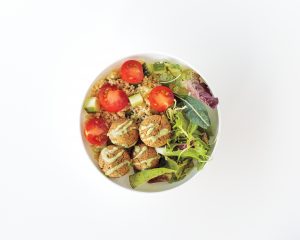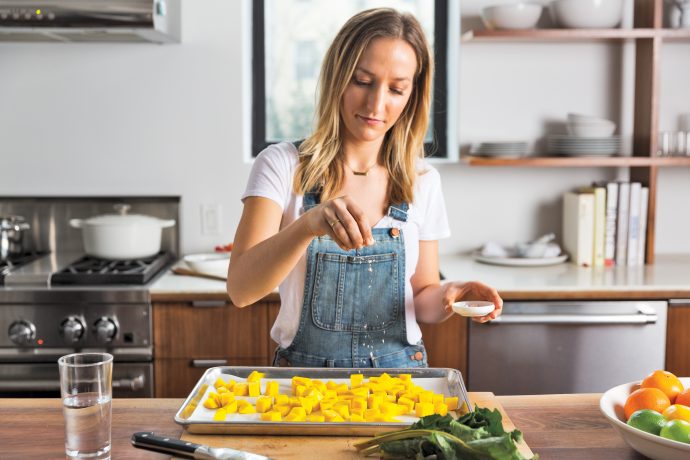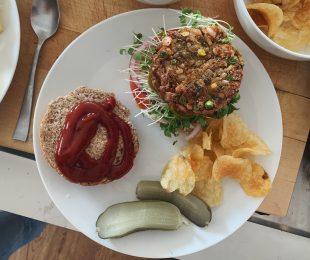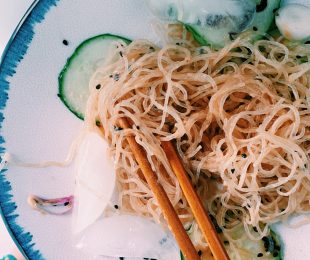“I BELIEVE IN NOURISHMENT,” SAYS LILY KUNIN OF CULT BLOG CLEAN FOOD DIRTY CITY. “Whether you are going for a detox dish or restoring dish, you’ll find that many of my detox recipes are actually warm, satisfying, and filled with tons of nutrients.” In that spirit, the blogger-turned-cookbook author’s new vibrant tome Good Clean Food is full of recipes that seek to nourish whatever your body is craving in that moment whether it’s a grounding grain bowl or a bright zesty smoothie. Below, we caught up with the queen of smoothie bowls who talked navigating a Manhattan kitchen without a dishwasher, her biggest crowd-pleaser recipe and why her beauty cabinet and kitchen cabinet have become one and the same.
Photo by Andrew and Gemma Ingalls
What ingredients or principles in your opinion makes for Good Clean Food?
It means eating really delicious, satisfying food that is also good for you. It’s about tuning into your body and how it feels and nourishing what it needs in that moment. On a sunny spring day that may mean making a gorgeous arugula + roots salad or on an under-the-weather-day it may mean making a big pot of red lentil earth curry. That’s Good Clean Food.
In your opinion, what three tenets make for a detoxifying dish vs a restoring dish? At one points do you crave either?
My detoxifying dishes tend to include ingredients that support the body’s natural detoxification process like dark leafy greens, beets, radishes, lemon, cilantro, hydrating vegetables, while my restorative dishes include healing ingredients like turmeric, ginger, mushrooms, raw honey, seaweed, and fermented veggies. You can’t go wrong with either!
What is your favorite recipe in the book that you find yourself making the most whether it’s for yourself or friends?
I love them all and my favorite varies with the season and how I’m feeling. I’ve been making my red lentil earth curry all winter long and it’s a big crowd pleaser. With spring just around the corner, I’m making lots of sesame noodle bowls and lentil tacos.
You break down kitchen and pantry essentials in your book. What are three things every studio apartment needs to make Good Clean Food?
Good Clean Food was born in my tiny West Village apartment when I had two roommates, no dishwasher, and virtually no counter space! You can make so many things with one good pot, a sharp knife, and a cutting board.
You outline beans and grains in the book as well as soaking. What is the benefit of soaking grains?
Soaking grains unlocks their nutritional power and can make them more digestible. Grains contain phytic acid, which can prevent you from absorbing all the nutrients. Soaking helps reduce the phytic acid, making more nutritious meals that are easier on the stomach. Let’s be honest – this doesn’t always happen – but it can be highly beneficial.
You are the queen of making beautiful bowls? What are tips to making a smoothie or grain bowl Instagram-worthy?
I love to keep it simple and let the natural beauty of fruits and vegetables shine – like the golden yellow turmeric or the bright fuchsia beets. I love incorporating a rainbow of colors and it’s not all in vain. Eating the rainbow also means you are eating a wide spectrum of nutrients. I like to top my bowls with a special garnish like candy beets, watermelon radishes, microgreens, crunchy sprouts or ruby sauerkraut – which takes it to the next level visually and taste-wise. Snap a photo in natural night and you’re good to go!
Bobbi Brown wrote the foreword of your book, did she give you any advice while writing the book?
Bobbi has written several books, and I remember worshipping Teenage Beauty as a girl. The message was so important, inspiring confidence in natural beauty (and of course a little makeup never hurt). Today, we share the same philosophy of beauty from the inside out. When you take care of yourself, you feel good and that reflects on the outside. Bobbi has been an incredible support throughout the process of writing my first book and I was happy to contribute all the recipes for her book, Beauty From The Inside Out, which comes out in April!
You include many beauty recipes in the book. What is your favorite homemade beauty remedy?
My kitchen cabinet and my bathroom cabinet has become virtually interchangeable so it only felt natural to include some of my go-to homemade beauty recipes. My favorite has to be my healing honey face mask – it’s manuka (or raw) honey, turmeric, lemon and a drop of tea tree oil. It’s super healing and anti-inflammatory.
Describe your own morning and evening holistic beauty ritual.
In the morning, I drink a glass of water when I wake up and warm up some bone broth on the stove. This has made all the difference in my skin. If I have some parsley on hand, I’ll mash it up and drop it in the broth along with a squeeze of lemon (I borrowed this idea from Brodo!) A bit later, I will make a matcha latte with coconut butter, tocos, cinnamon and whatever else I feel like throwing in… along with eggs for breakfast. I love slow ritual like mornings and I always wake up looking forward to my morning latte. Then, I’ll wash my face, alternating warm and cool water, spritz with a probiotic toner, and massage in my favorite face oil. I always remember to dry brush on days I’m feeling a bit more tired than usual and am in search of a natural energy boost.
In the evening, I usually need to wash away a day of city dirt and grime so I aim to massage my cleanser into my skin for a minute or so, although on extra tired days this might not happen. I spritz again with my probiotic mist and massage in the same oil as the morning. A few nights a week I run an extra hot bath and soak with a healing honey face mask on. I love Dr. Singha’s mustard bath and CAP Beauty’s Love Bath. Once a week or on nights before a big event, I’ll do Juice Beauty’s Green Apple Blemish Clearing Peel. It makes my skin extra smooth and bright. I’m a product junkie so I’m working on simplifying my beauty ritual – holistic or not – but I think I’m finally getting there!
What are three plant-based ingredients you could live on forever?
Avocado, mango, and coconuts.
Lily’s Mediterranean Falafel Bowl from Good Clean Food

INGREDIENTS
MAKES 20 FALAFEL; SERVES 4
Mediterranean grain salad
- 1 cup millet
- Sea salt or pink salt
- 1 English cucumber, unpeeled, seeded, and cut into medium dice
- 1 pint cherry tomatoes, halved
- 1/2 cup chopped parsley
- Juice of 1 lemon
- 1/3 cup olive oil
- Freshly ground black pepper
Herbed falafel
- 1/3 cup walnuts (or almonds)
- 2 cups cooked chickpeas (or one 15-ounce can, rinsed and drained)
- 1/2 yellow onion, chopped
- 2 garlic gloves, minced
- 2 tablespoons olive oil, plus more for brushing
- 1 tablespoon tahini
- Juice of 1 lemon
- 1 tablespoon buckwheat, chickpea or other gf flour
- 1 teaspoon baking powder
- 1 teaspoon ground cumin
- 1 teaspoon sea salt or pink salt
- 1/4 cup mixed herbs (such as parsley, mint, cilantro, and chives)
- Freshly ground black pepper to taste
Green tahini dressing
- 1/2 cup tahini
- 1/2 cup parsley
- Juice of 2 lemons
- 2 garlic cloves, minced
- Sea salt or pink salt
- Freshly ground black pepper
Serve with: mixed greens or arugula and hemp hearts
METHOD
Preheat the oven to 375F. Line a baking sheet with parchment and set aside.
For the salad: In a large pan, toast the millet over medium heat for 3 to 4 minutes, or until the grains start to turn golden brown. Meanwhile, in a small pot, bring 2 cups water to a boil. Add the millet and a pinch of salt, stir, cover, reduce the heat, and simmer for 15 to 20 minutes. Remove the pot from the heat and cover it with a kitchen towel to let the millet steam for 5 to 10 minutes. Gently fluff the grains and let them cool to room temperature.
Meanwhile, combine the cucumbers tomatoes, parsley, lemon juice, olive oil, salt and pepper in a large bowl. Once the millet is nearly cool, add to the bowl and stir well. Season with salt and pepper to taste.
For the falafel: In a food processor, pulse the walnuts until they are fine and crumbly. Add the chickpeas, onion, and garlic, and pulse a few more times. Add the remaining ingredients and pulse until a nice texture is achieved and the ingredients are well combined. Use a tablespoon-size cookie scoop or a tablespoon to scoop out the mixture. Moisten your hands with water or oil and gently roll the mix into balls and place them on the parchment. Repeat with the remaining mixture. Use a pastry brush to brush the tops of the falafel with oil. Bake for about 25 minutes, or until the falafel is golden on all sides, flipping them halfway through.
For the dressing: In a food processor or blender, blend the tahini, parsley, lemon juice and garlic until well combined. Slowly drizzle in water as needed until you reach a pourable consistency. Season with salt and pepper to taste. Store in an airtight container in the fridge for up to 4 days.
Serve the falafel in a bowl with the millet salad, greens, hemp hearts, and a generous drizzle of the tahini dressing. Enjoy!





2646 Comments